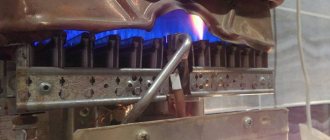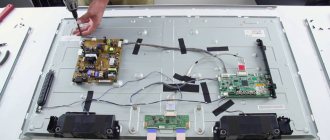Do you use a gas water heater as a water heater, but all of a sudden it started making a strange noise when turned on? Unfortunately, any equipment does not last forever and breakdowns happen at the most unexpected moment. But a number of simple malfunctions can be fixed on your own. You are planning to try to fix the speaker yourself, without waiting for the technician to arrive, right? But you don’t know why the gas water heater turns on with a bang and where to look for the source of the problem?
We will help you figure it out - this article discusses the most likely causes of cotton in older and newer models of geysers. The material is supplemented with visual photos and video recommendations for troubleshooting and troubleshooting.
Why does popping occur most often?
A popping sound when turned on most often occurs in old-style speakers where there is a constantly burning wick. In new generation dispensers, where the gas is automatically ignited, a malfunction occurs, but not so often.
So, the pop is heard due to the late ignition of the gas in the burner, which manages to accumulate in large quantities. Therefore, when the gas finally ignites from the flame of the wick or from the spark of the igniter, the user hears a loud bang. But this situation is extremely dangerous if left unattended - over time, the gas-air mixture, before it ignites, will begin to fill part of the chimney pipe, which is fraught with a serious explosion.
A working column of any configuration should turn on without flames or pops, softly and quickly.
There are common causes of popping noise when turned on, which you can independently diagnose and quickly eliminate.
Let's look at the most common causes of such trouble in columns of all types:
- ignition retarder malfunction;
- insufficient supply of fresh air to the room;
- insufficient draft or its absence (in the chimney).
For wick columns, the most common failure is when the flame in the wick element is in the wrong position.
For models with automatic ignition, the reason may be:
- incorrect position of the candle;
- microswitch malfunction;
- discharged power supply in the control unit.
Let's take a closer look at the main causes of cotton and the features of determining the source of the problem.
Reason #1 - weak traction
Combustion products exit through the chimney. This happens quickly, but if the steam or carbon dioxide does not have time to cool, it can fall back into the column and cause contamination of the air-gas mixture. We also recommend that you familiarize yourself with the causes and methods of eliminating backdraft in the chimney.
If there is weak draft, the column often lights up with a certain pop. Once you establish the cause of the weak draft and eliminate it, the extra noise will no longer bother you.
To check the draft, there is a special hole at the top of certain columns and boilers - a control hole. It is located on the casing. The test can be done simply: bring your hand to this hole, you should feel a pull. You can also use a match. Sufficient draft is determined by the deviation of the flame from the vertical.
A similar operation can be performed using the hatch that is equipped with the chimneys of gas boilers. If necessary, through the same hatch you can clean and remove debris.
You can check the channel for debris using a regular mirror. It will be placed through the hatch into the channel. If a gap is visible, then the channel is clean. And if there is no draft, then in this case the help of specialists will be required to remove the accumulated soot, which has caused the narrowing of the pipe diameter.
Also, the cause of insufficient draft or its absence can be poor ventilation when there is no air flow into the room. Safety precautions indicate that you can use a gas water heater if the room is ventilated (an open window, a ventilated window). Also in such a situation, installing a supply valve in the wall or mounting the valve on plastic windows will help.
Reason #2 - the batteries are dead
If the batteries in a dispenser with an automatic ignition system are low, a popping sound will occur when you turn on the water. The lack of electricity to instantly produce a spark causes a cracking sound that is prolonged. At this moment, fuel accumulates in the work area, and when a spark occurs, there is a loud bang.
Dead batteries cause a problem with a serious crackling and popping noise when the speaker is turned on. Therefore, batteries need to be changed promptly
One of the main factors in determining this problem can be considered the presence of a characteristic crackling sound, which indicates that ignition was not carried out. The problem can be resolved by simply replacing the batteries.
Reason #3 - nozzle contamination
Semi-automatic models equipped with piezo ignition have a flame formation system from the wick.
If the nozzle becomes clogged or starts to work incorrectly, the burning intensity of the wick becomes minimal - insufficient for timely ignition. To fix this problem, the jet simply needs to be cleaned.
Cleaning the nozzle is done carefully, since damage to this element will require its replacement, and this is a rather labor-intensive procedure.
Cleaning the jet is a simple process. After removing the casing, simply clean the holes using thin and soft wire. You also need to check the position of this element. If necessary, move it a little closer to the burner.
Reason #4 - clogged burner holes
If the holes of the main burner are clogged, in addition to the fact that there will be a pop when turned on, significant noise will be heard during operation. In order to fix this problem, you need to disassemble part of the column. Clean the burner with a soft brush (clogs will be visible). There is no need to unscrew the jets from the frame, but it is also recommended to clean their holes.
You can clean the gas water heater burner immediately after removing the casing, using thin and flexible copper or aluminum wire. But cleaning must be done with extreme caution.
Reason #5 - poor gas quality
Often the cause of cotton is gas, which contains a significant amount of additional impurities. Due to the presence of such impurities, it flashes loudly - this noise is similar to cotton.
To make sure that the reason really lies in the quality of the gas, you just need to ask your neighbors if they have the same problem. If the quality of the fuel is poor, a similar situation will be present in all residents of the house.
Reason #6 - casing deformation
Thermal effects (heating and cooling) can cause deformation of the casing. This problem occurs frequently. If the deformation occurs inward, the spark plug may pierce the body.
If deformation is detected, the concave part will need to be bent slightly.
The cause of the popping sound when turned on may be deformation of the casing or poor gas quality. In the first case, you can correct the situation on your own, and in the second, contact the gas service
How does a gas water heater work?
Two main elements are responsible for heating the water in the column:
- gas-burner;
- the heat exchanger, which is located above it, is a spiral tube through which heated water passes.
The rest of the gas apparatus consists of the following components:
- Ignition. In “prehistoric” Soviet models, this role was played by a wick or igniter, which was lit with a match. Now a piezoelectric element is responsible for this, which only requires the user to press a certain button.
- Water-gas device. Its elements are a gas valve and a membrane installed in the water supply. When you open the water, it starts moving through the column. Due to the water flow, the membrane bends, opening the gas valve, allowing gas to be supplied to the burner.
- The safety automation includes a solenoid valve to which sensors are connected to monitor the uninterrupted operation of the device. If any problems are detected, the sensors instantly close the valve and the column stops working. If we are talking about devices with igniters, then a thermocouple is also attached to the valve, which is heated by the flame. When the burner goes out, it fires.
Features of repairing old models
First of all, you need to determine why the geyser slams and makes noise when you turn on the water, and if all of the above shortcomings have already been eliminated, but the cotton still persists, then you need to check the functional condition of the product.
Let's start by looking at simple samples of equipment with wicks that are used to ignite a flammable mixture.
In such models, a loud popping noise often occurs when the design parameters do not match the flame contours. Timely ignition of the burner does not occur if the fire size is small or too large. The cause of this problem is considered to be mechanical clogging of the nozzle holes. Through these holes, a dosed supply of gas is formed.
Old models of geysers break down. The cause of the popping sound when turned on is most often a clogged nozzle, burner, or lack of traction
To troubleshoot the problem you will have to do the following:
- The main casing is dismantled in order to provide full access to all internal components of the column.
- The block where gas and air are supplied (many manufacturers use this structure) must be disconnected from the pipe system.
- Next comes cleaning the nozzle. The most commonly used wire is a soft type of metal. It can be copper or aluminum. The procedure is carried out carefully, so that the calibrated hole is not damaged.
- Assembly is performed in the reverse order, paying special attention to the integrity of threaded connections and seals.
The jets may become clogged in the main burner. With such a blockage, switching on is also carried out with a bang. When disassembling the device, you need to remember that some components and elements, for example, gaskets, valves, thermocouples, are not very durable, so they must be handled extremely delicately.
How to determine power
First of all, you need to decide on the power or performance of the gas water heater. These are two interrelated characteristics that simply reflect different characteristics of the unit. Performance is how many liters of water a column can heat per minute, and power is how much heat it can release. Some manufacturers indicate power, others indicate performance, so you need to understand exactly what you need.
Let's first figure out what kind of performance you need from your geyser. This depends on the number of consumers who need to be provided with warm water. There are consumption standards for different types of equipment:
- kitchen sink, washbasin - 4 l/min;
- shower - 7-10 l/min.
If you have a kitchen sink, shower and washbasin connected to hot water, so that all three points work simultaneously and the water temperature does not drop, you need a capacity of 4 + 4 + 10 = 18 l/min. This is a lot, the price tag will be substantial. If you think about it, you will realize that all three devices are almost never turned on at the same time. There are situations when the shower and one of the taps work together. To provide them with hot water, the capacity must be 14 l/min. This is a little more modest, but quite enough for a comfortable stay. Look for the found value in the technical specifications; it should not be less.
Now let's look at power. Gas water heaters can allocate from 6 kW to 40 kW of heat for heating water. Here the division is:
- a gas water heater with a capacity of up to 19 kW is suitable for heating water for one water collection point;
- for two points the power should be from 20 kW to 28 kW;
- three require more than 29 kW.
Now, you can definitely say which geyser is better in terms of power in relation to your needs.
Troubleshooting new equipment
New equipment may also experience various problems. Most often they manifest themselves in the operation of the flow sensor, in the operation of the candle, or in the power system. Let's take a closer look at these problems.
Column microswitch failure
Often the problem with a loud bang during ignition is the insufficient discharge of batteries, which provokes the inability to instantly ignite the gas-air mixture.
The power supply is connected to the control unit via special microswitches, which are responsible for generating a signal to activate the ignition when the DHW tap is opened. If the signal arrives at the wrong time, this causes the problem. This malfunction occurs most often due to oxidized contacts. The microswitch cannot be repaired; it will need to be replaced.
If the microswitch breaks down, repairs cannot be carried out, since this system will have to be completely replaced
Flow sensor malfunction
Often the problem with popping is the flow sensor. It is located in the input circuit. A signal is sent to the control unit controller indicating the presence of liquid in the pipe. The data instantly activates the ignition system. Intensive use of this element creates an increased risk of breakdowns. For example, contact groups can be oxidized.
Such sensors are most often manufactured in a non-separable design, therefore, if a problem occurs, they cannot be repaired and must be replaced.
Working candle offset
The problem may be with the spark plug. After applying voltage, it provokes the formation of an electric spark. Modern candles are made in such a way that they can last for a long time. Element failures are rare, but they do happen.
The most common occurrence is that the ignition device is displaced relative to its nominal position. It can occur as a result of repeated heating and cooling. Such processes are associated with changes in the dimensions of individual structural elements. As a result of adjusting the position of the spark plug, the spark parameters become normal, and extraneous noise completely disappears.
Incorrect operation of the ignition retarder
A rare breakdown is considered to be incorrect operation of the ignition retarder. When disassembling the column, you need to remove the water regulator. On its cover there is a hole in the bypass channel, in this hole the ball is located. The adjusting screw determines the position of the ball.
If, when shaking the lid, you hear the sound of a moving ball, then you should not manipulate this part further. If there is no knocking, then you can move the ball using a thin copper or aluminum wire through the passage channel hole, which is located in the regulator cover.
Most often, the retarder is a ball of metal or plastic that blocks part of the bypass channel in the water regulator. In most column designs, this moderator is located in the boss of the water regulator cover.
As a last resort, you will have to resort to the procedure of parsing the element. It must be said right away that the external screw does not affect the position of the ball in any way. The inner screw must be removed very carefully. You should first remember its original position, and also clearly determine the number of revolutions by which this screw is screwed. This will allow you to maintain the required location of the element (ball) during subsequent assembly.
After repair work, be sure to check all connections to completely eliminate leaks of both water and gas. All connections must be treated with a sealant to ensure tightness. After which you can put the casing in place and use the column as usual.
What if the equipment is still noisy?
If, after these manipulations, the gas water heater still ignites with a bang when you turn on the water, then it is better to stop further independent research. In such situations, you will have to seek help from qualified specialists.
They will carry out competent diagnostics of the equipment, will be able to clearly determine what is causing the cotton and, based on the data obtained, will be able to provide you with options for solving the problem.
In certain cases, independent repair is impossible, then cooperation with qualified specialists will be a rational solution.
Key reasons
According to experts, the key reasons for the explosion of a gas water column are:
First: installation and connection to the network using your own efforts. Installing a speaker is not that difficult. But only professionals should connect it to the network. The necessary documentation and permits must be collected. The owners contact the gas company. Its employees arrive upon request and carry out the necessary work. After which the equipment is ready for use.
Second: old equipment. Usually these are Soviet columns that do not have defensive mechanisms. They do not have controllers or thermostats that monitor the operation of all components.
It has been scientifically and practically proven that an explosion of a geyser in an apartment can occur if the gas is concentrated in the air by 5-15%. The same factor applies to the home.
Third: independent changes in the design of the device. It is forbidden to change its device in any way with your own hands. If the unit malfunctions, it can seriously break down or even explode.
Conclusions and useful video on the topic
Find the reasons why a gas water heater turns on with a bang and how to eliminate them in the following video:
There are many reasons why extraneous sounds occur when turning on a speaker. Most can be diagnosed independently and you can try to fix the problem yourself. If you still cannot determine the cause of the breakdown, then the only solution in this situation is to contact gas equipment repair specialists.
Would you like to tell other users about your experience in finding the cause of the geyser popping? Or do you still have questions that we did not pay attention to in this material? Ask them in the comments block - our experts will try to help you. Share your experience, take part in discussions - the contact form is located below.
Diagnostic method
If you decide to carry out repair work yourself, the owner must strictly follow the instructions. First of all, experts advise checking the intensity of the chimney draft. The main part of the geysers is equipped with a casing, which has holes provided just for this procedure. If the column manufacturer has not made such holes, the draft can be checked right next to the slot located at the smoke hood. In addition, the draft is perfectly felt at the chimney cleaning hatch.











